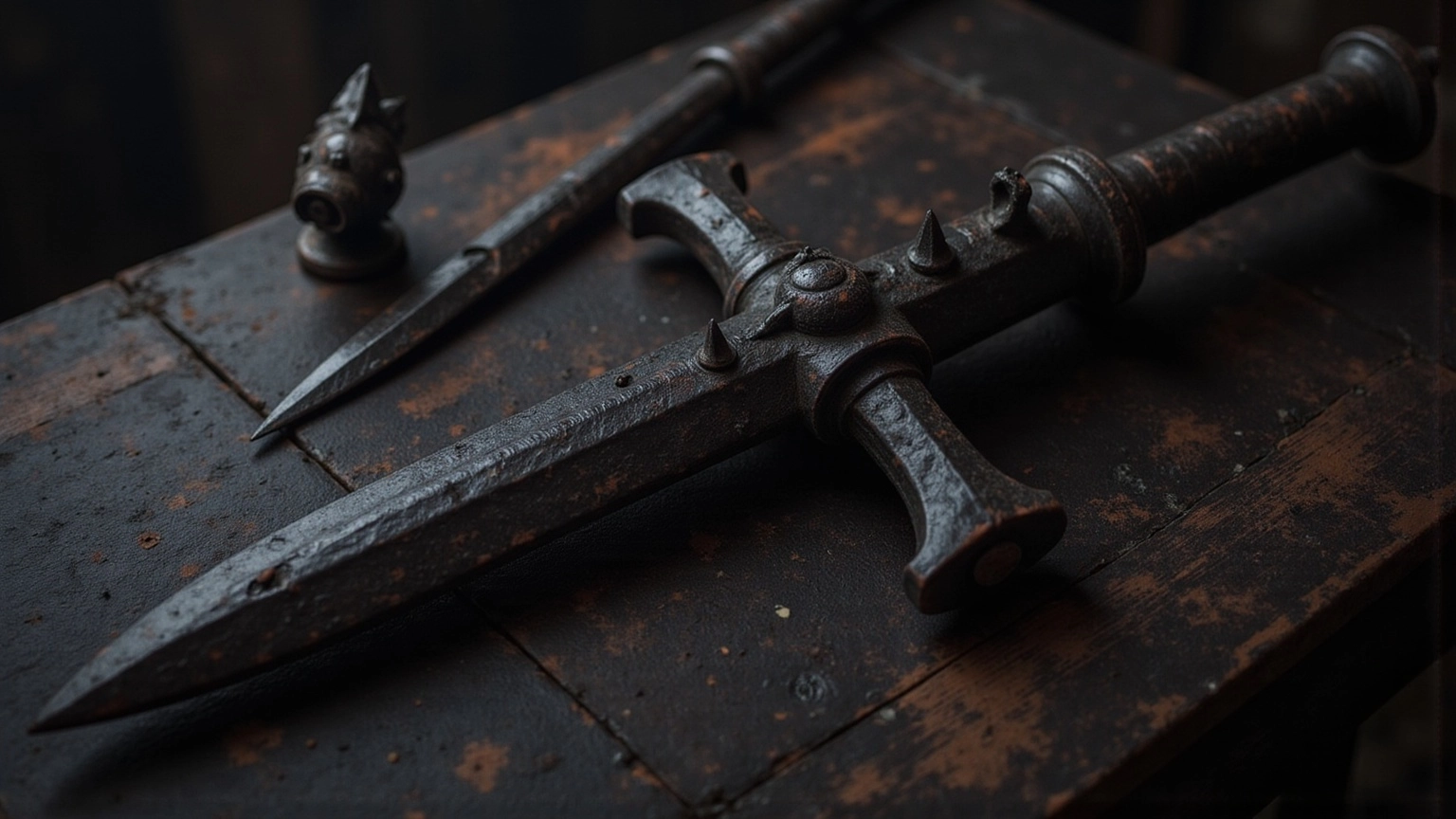
Understanding the Aztec Obsidian Sword: The Macuahuitl
Share
Overview
Step into the world of the Macuahuitl, the Aztec obsidian sword that slices through history. This isn’t just a weapon; it’s a fierce cultural emblem, a testament to power and status in the Mesoamerican arena. Crafted from wood and obsidian, its design is as lethal as it is striking—each blade a whisper of the warrior's might, echoing the brutal dance of battle and the rich tapestry of cultural identity.
Can you feel the weight of its significance? In the hands of Aztec warriors, the Macuahuitl was more than a tool of war; it was a statement, a declaration of dominance, intertwining the threads of warfare and identity in a tapestry as complex as the obsidian itself. This sword doesn’t just cut; it carves out a legacy, a narrative steeped in the shadows of history.
So, what does it mean to wield such a symbol? To embrace the duality of destruction and identity? The Macuahuitl dares you to ponder the depths of its significance, urging you to explore the fierce interplay between power and culture. Dive deep into this gothic tale of weaponry and legacy, where every strike tells a story, and every warrior is cloaked in the rich, dark fabric of history.
Introduction
The macuahuitl—what a marvel, a fierce blend of artistry and lethal efficiency. It’s not just a wooden club; it’s a weapon adorned with sharp obsidian blades, ready to unleash devastation on the battlefield. But it’s more than mere practicality. This weapon pulses with the status and power of elite Aztec warriors, a testament to the intricate dance between martial might and cultural identity. Dive into this exploration, where the macuahuitl emerges as a pivotal player in Aztec military strategies, encapsulating rich historical narratives that continue to enthrall historians and enthusiasts alike. Are you ready to uncover its secrets?
Defining the Macuahuitl: The Aztec Obsidian Sword
Picture this: an ancient blade, a relic of Mesoamerican ingenuity, resembles a wooden club more than a typical sword. Its name? A nod to the Nahuatl language, translating to 'hand-wood.' This striking tool, known as the aztec obsidian sword, is a wooden structure embedded with razor-sharp blades that boasts an edge sharper than high-quality steel. The aztec obsidian sword was not merely a weapon; it served as a badge of honor and a symbol of power among the Mexica warriors. Crafted with precision, each obsidian piece, about 1.125 inches (4 cm) long, was designed for effective cutting and slashing in the heat of battle. Historian Marco Cervera Obregón noted its significance, a profound connection among diverse cultures, embodying a shared heritage that resonates even today.
But the tale takes a tragic turn—one ceremonial sword, an aztec obsidian sword that was once housed in the Royal Armory in Madrid, was lost to flames in 1884, serving as a haunting reminder of its historical weight. The legacy of this aztec obsidian sword is undeniable. The aztec obsidian sword transcends mere combat; it stands as a cultural artifact, a testament to the values and artistry of a civilization. Its craftsmanship and symbolic depth reveal the intricate dance between conflict and social standing in Mesoamerican culture. This weapon captivates historians and enthusiasts alike, inviting them to delve into its story, to explore the shadows and whispers of a past that still echoes in the present.

Historical Context and Cultural Significance of the Macuahuitl
In the shadows of ancient warfare, the aztec obsidian sword was no mere tool; it served as a symbol of power, a ceremonial artifact steeped in ritual. Elite warriors wielded the aztec obsidian sword, showcasing their prowess and status like a badge of honor. The Aztecs? They didn’t just fight; they captured foes for sacrifice, a chilling reflection of their beliefs that human offerings were the ultimate tribute to their gods. Spanish conquerors chronicled the fearsome reputation of the aztec obsidian sword, highlighting its lethal effectiveness in battle and its pivotal role in the empire's military strategies. What does this say about the intertwining of culture and violence? Dive deeper into the dark allure of this ancient civilization and discover the seductive power of its legacy.

Materials and Design: The Obsidian Edge of the Macuahuitl
The Aztec warriors wielded a weapon like no other. Picture this: a robust wooden base, carved from resilient oak, built to withstand the chaos of battle. But it’s the obsidian blades—razor-sharp, glistening like dark jewels—that truly steal the show. Obsidian, volcanic glass forged by nature, boasted an edge sharper than steel. This wasn’t just a weapon; the aztec obsidian sword was a lethal masterpiece, a testament to the Aztecs' mastery over materials.
Imagine the duality of its design—capable of slashing and bludgeoning, it thrived in the heat of combat. Historical whispers tell of the macuahuitl’s prowess, with one notable piece resting in the Royal Armory of Madrid, lost to flames in 1884. A tragedy that echoes through time, highlighting not just a weapon, but a legacy—the Aztec obsidian sword and its creative application in Mesoamerican warfare that carved its mark in military history.
Mark Cartwright captures it perfectly: obsidian transcends its physical form, entwined with the cultural narratives of Mexico’s indigenous peoples. Legends swirl around Motecuhzoma II, the last true ruler, who believed in the mystical powers of obsidian mirrors. This weapon, the aztec obsidian sword, represents not just combat but also a bold declaration of the Aztecs' innovative spirit and their deep-rooted connection to a material that is as enigmatic as it is powerful.
So, what does this mean for us? Dive deeper into the shadows of history and explore the rich tapestry of culture and combat that obsidian represents. The Aztecs didn’t just fight; they forged a legacy that challenges our perceptions of power and artistry.
Warfare Applications: The Macuahuitl in Battle
In battle, the wooden sword was more than just a weapon; it was a fierce companion in close combat. Warriors wielded it against foot soldiers and mounted foes alike, a brutal dance of slashing and bludgeoning. Its design? A masterpiece of lethality that could decapitate, striking fear into the hearts of enemies. Young fighters were not merely trained; they were forged in its use from an early age, a testament to its pivotal role in the military culture of their civilization.
This training was steeped in the Aztec tradition of capturing enemies for sacrifice, a ritual entwined with their religious fervor and societal norms. The macuahuitl dominated close-quarters engagements, where its lethal design merged with a warrior's skill, creating a symphony of destruction. Tactical training and the psychological weight of this armament amplified the civilization's military might, solidifying their dominance in the region.
The formation of the Triple Alliance in 1428 between Tenochtitlan and Tlacopan? A strategic masterstroke that enhanced the Mexica's warfare capabilities. Campaigns like those chronicled in "The Victor's Spoils" led to new territories and a tribute system, a steady stream of resources that fortified their power.
Historian Mark Cartwright reveals the Aztecs' multifaceted combat strategies—diplomacy and direct assaults—essential elements that sharpened their battle tools. This gritty approach to warfare, paired with the aztec obsidian sword's deadly potential, cements its place in the Aztec military arsenal. What does this say about power, culture, and the art of war? Dive deeper, and explore the shadows of history that shaped a civilization.
Conclusion
The macuahuitl isn't just a weapon; it’s a fierce embodiment of Aztec ingenuity and artistry. Picture this: a sturdy wooden base armed with razor-sharp obsidian blades, a lethal tool of warfare and a badge of honor for elite warriors. Its edge? Often sharper than steel, a testament to the Aztecs' masterful craftsmanship and their deep understanding of materials.
In the realm of Aztec culture, the macuahuitl was a dual force—both a combat instrument and a ceremonial artifact. It was pivotal in military strategies, especially in capturing foes for sacrifice, a ritual steeped in their religious fervor. Spanish conquistadors noted its fearsome reputation, a weapon that not only struck down enemies but also instilled dread in the hearts of adversaries.
This legacy? It’s profound. The macuahuitl intertwines warfare, societal status, and cultural identity in Mesoamerica. Its design, capable of slashing and bludgeoning, speaks to the versatility demanded in close combat. Young warriors underwent rigorous training in its use, highlighting its central role in the military culture that propelled the Aztecs to dominance.
Ultimately, the macuahuitl transcends mere weaponry; it encapsulates the intricate dance between martial prowess and cultural significance within Aztec society. As it continues to enthrall historians and enthusiasts, this weapon serves as a haunting reminder of the rich heritage and innovative spirit of the Aztecs. Its story echoes through time, illustrating the deep connections between weaponry, culture, and identity. So, what does the macuahuitl whisper about our own battles and beliefs today?
Frequently Asked Questions
What is the aztec obsidian sword?
The aztec obsidian sword, also known as macuahuitl, is a wooden structure embedded with razor-sharp blades made from obsidian, which is sharper than high-quality steel.
What does the name "macuahuitl" mean?
The name "macuahuitl" translates to "hand-wood" in the Nahuatl language.
What was the significance of the aztec obsidian sword in Mesoamerican culture?
It served not only as a weapon but also as a badge of honor and a symbol of power among Mexica warriors, reflecting the values and artistry of their civilization.
How were the obsidian pieces designed for the sword?
Each obsidian piece was about 1.125 inches (4 cm) long and crafted for effective cutting and slashing in battle.
What historical event impacted the legacy of the aztec obsidian sword?
A ceremonial aztec obsidian sword housed in the Royal Armory in Madrid was lost to flames in 1884, marking a tragic loss in its historical legacy.
Why does the aztec obsidian sword attract the interest of historians and enthusiasts?
Its craftsmanship, symbolic depth, and connection to Mesoamerican culture invite exploration of its story and the historical context it represents.
